ARTILLERY AT BASTOGNE
(Editor's note: In the five campaigns in which the artillery participated, non exemplified the versatility, courage, and aggressiveness of the artillery as well as the Battle of the Bastogne Bulge. The following article is included as a fair and accurate record of the role of the artillery in the 6th Arnold Division.)
After 150 consecutive days of active combat operation in support of the advance of the 6th Armored Division across Brittany and France to Sarreguemines, France, the artillery battalions of the Division marched to Metz, France, on December 24, 1944. Orders were received at 1315A Christmas day to proceed to the vicinity of Nommern, Luxembourg, preparatory to relieving the 10th Armored Division. This was accomplished on 26 December. On 29 and 30 December, after relief by the artillery of the 5th Infantry Division plans and reconnaissance were rushed for employment of the three organic 105 self propelled artillery battalions of the division, the 128th, 212th and 231st, with attachments, for the future operations in the vicinity of Bastogne, Belgium.
Due to the critical aspect of the tactical situation then prevailing, and the urgent need for immediate movement to positions from which the attack of Combat Command "B," scheduled to occur on the morning of 30 December could be properly supported, the battalions marched under cover of darkness, to their previously surveyed positions; occupied them despite snow, cold, and unfavorable road conditions, and were ready to support the attack. Because climatic and road conditions were so adverse, the -attack was postponed, but the artillery was the first element of the Division to be in position and ready for the fight.
The initial attack was launched on 31 December by CC "A." Although each of the two artillery groups was disposed primarily for the mission of rendering close support to its particular combat command, by careful selection of positions, close liaison, and the installation and maintenance of a workable and efficient system of communications, all battalions were able to fire in mutual support of either Combat Command. This was done with extremely good effect on the first day of the attack. Prior to the "jump off," fires were placed on Wardin, Mageret, Arloncourt and Oubourcy. During the attack, enemy artillery positions were neutralized; road junctions in rear of the German lines interdicted; and enemy infantry assemblies in woods subjected to accurate and devastating fire. Tanks, machine guns, and personnel of a determined and well equipped enemy were subjected to repeated artillery fire that was in most cases observed and known to be effective. Including harassing and interdiction fires that were maintained throughout the night, a total of 3272 rounds was fired on the first day of the battle.
From the period 1 January until 8 January 1945, the greatest artillery battle of the war was fought. Moving to positions on the outer fringe of the bulge into the southern flank of the German spearhead, with headquarters of both groups in Bastogne, the artillery fought ceaselessly day and night, without rest or respite, in bitterly cold weather. Biting winds, blinding snow and sleet; ice covered supply roads, drifted high with snow, created tremendous difficulties of supply and ammunition. Observation was difficult; liaison air activity was restricted to a minimum. Despite these almost insurmountable difficulties in the face of the most determined efforts on the part of the best troops in the German army to crack the Bastogne defense, the artillery, time after time, inflicted extremely heavy casualties on enemy personnel and equipment. Artillery fire repeatedly broke up counterattacks as they were being formed. PW's complained of the accurate and devastating nature of the artillery fires, singling it out as the most damaging factor in their inability to press any attack to a successful breach of our defense.
Every artillery battalion was shelled repeatedly and the habitually selected and surveyed alternate positions were occupied many times under the most trying conditions of enemy shell-fire, weather, and terrain restrictions. Bastogne itself was under continuous shell-fire from all calibers of German artillery. It was bombed by planes of the Luftwaffe, as were the positions of the battalions. In battle vernacular, the whole area was "red hot" during this entire period, but not once did supported units find the artillery, for any reason at all, unable to give them the fires they wanted, whether of a planned or emergency nature, and of the latter there were many instances of extreme urgency. Close liaison with the artillery supporting the 101st Airborne Division, and with the III Corps Artillery, enabled the fires of the artillery supporting the 6th Armored Division to be effectively intensified on occasions when it was imperative that all available supporting fires be delivered. Similarly there were many calls from the 101st AB Div. and from III Corps Artillery for fires outside the 6th Armored Division Zone to assist in repulsing dangerous enemy attacks. Shifts of 3200 mils in response to these calls were accomplished on several occasions. So important was the need for immediate delivery of fire to assist adjacent units to stop counterattacks that one battery in a battalion would remain laid on an azimuth of approximately 3000 mils from its normal direction of fire for several hours at a time. On 3 January the artillery of the 6th Armored Division fired 16 missions on call from the 101st AB Div. Arty. in repulsing two counterattacks in their zone. On 5 January, 11,655 pounds were fired by the artillery in support of the 6th Armored Division. During the seven days from 1 to 7 January inclusive this same group fired a total of 53,054 rounds. While the total amount of ammunition fired is in itself significant in that it is indicative of the violent and continuous nature of the fighting, it was even more important that it shows the extent of reliance placed in the artillery to stop the enemy. The artillery literally saved the day, not once, but on numerous occasions.
From 3 to 20 January the battle raged with unabated fury. This period was marked by repeated attempts on the part of the Germans to break through our defenses by launching attacks against the semi circle around Bastogne from all sides except the south where a narrow supply corridor leading into the city was held by American troops. Attacks and counter-thrusts were launched daily by both sides.
This called for extreme versatility in the use of the artillery. Tactically disposed inside the bulge, every conceivable type of fire was delivered, and except for the effectiveness of the artillery, the enemy would have undoubtedly surged into the battered area held by our harassed troops. Repeatedly, requests were received from the 35th Infantry Division on our right and 101st Airborne Division on our left, in addition to those in our own zone. Air observation posts operated constantly despite frequent snow flurries, snow and ice covered landing fields, and bitter cold weather. Their bravery and determination was of paramount importance because by observation our fires were made more effective and were known definitely to be inflicting enormous casualties both on enemy personnel and Equipment. Because of the flexibility of operations, involving certain task forces passing through others; difficulties of relief and the constantly changing situation, the artillery was confronted with, and solved, the most trying problems of any of the five campaigns in which it participated. Every available officer was used for observing and conducting artillery fires in foremost positions. During the entire period each battalion employed from 9 to 12 observers with forward elements, although the Tables of Organization for Armored Artillery Battalions provide only three. 48,190 rounds were expended during the 12 day period.
From 21 January to 25 January, the "see-saw" battle of the preceeding three weeks changed to one of pursuit. Every effort of the German troops to wipe out the bulge had been met with such determined resistance and devastating and damaging artillery fire that they were completely frustrated. The battalions displaced rapidly close on the heels of their supported commands, harassing the retreating foe and inflicting casualties on their depleted personnel and equipment. The effectiveness of the artillery fires during the preceeding phases was evident on all sides. Destruction was not the only accomplishment of the artillery, however, as during the offensive operations one of its most important roles was the screening of our movements by the extensive employment of smoke. That this was skillfully done is evidenced by the reduction in casualties to our infantry and tank battalions where smoke was employed in conjunction with their attacks. It was an important factor, and in each case contributed greatly to the success of our operations.
Because of the weight of the German attacks, the possibility of a sucessful penetration, the narrowness of the escape corridor, the decision as to whether the position areas for the artillery battalions should remain inside the bulge, or be changed to relatively safer areas farther to the south, presented itself to the Artillery Commander. Should the Germans succeed in their efforts to achieve a break-through, much if not all of the artillery, because of its nearness to the front lines, the narrowness of the escape corridor, and the extreme difficult of moving heavy equipment over the icy, snow packed roads, would be over-run. On the other hand, by being concentrated within the bulge, better all around support could be given. Greater range was afforded for interdiction and harassing missions, more prompt and effective support could be given to adjacent divisions; and shorter lines of communication provided more constant and better control.
The battle from the very beginning had the unmistakable earmarks of "winner take all." The role of the artillery was so indispensable, and so all important, and the issue so desperately contested by both sides that it was decided the artillery would stay inside the bulge where it could make its power felt best and quickest, regardless of danger to personnel or loss of equipment. That decision may well have been the margin by which the enemy's will was broken, as the ceaseless punishment inflicted on the German army by the artillery was, according to their own PW's, the most devastating single factor in their defeat.
As the battle progressed, the telling effect of our counterbattery fires was notable in the gradual decrease in the volume of enemy fires falling in our own areas. Using American weapons and captured ammunition that had been siezed during the early stages of the Ardennes offensive the Germans fired on our front lines while our own artillery was in action, hoping to create the impression among our front line units that their own artillery was firing short. This fact was established by shell reports and the discovery of fuses in the shell craters that were still set on "safe."
While the "Battle of the Bulge" could never have been won by the artillery alone, it was the super human effort of the artillery that prevented it from being lost on repeated occasions, and by the intensity and accuracy of its fire the way was paved for the final breakthrough and rout of the cream of the German Army, and marked the real beginning of the end of the war in Europe.
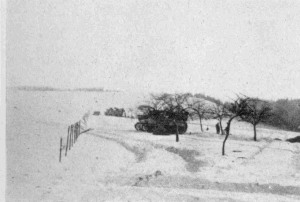
6 January
These 105mm SP guns of the 212th are set up to fire into enemy positions just north of the Belgian city of Bastogne.

Grounded because of blizzard, artillery liaison plane stands in snow covered field in vicinity of Bastogne in 6th Armored Division held territory.
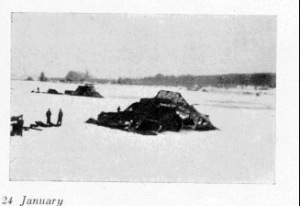
24 January
105mm SP howitzers are set in position in open country near Trois Vierges, Belgium.
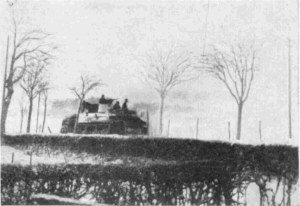
24 January
105mm self propelled gun of the 231st A. F. A. Bn. Rolls along snow covered highway in 6th Armored Division sector of Belgium enroute to new position near Trois Vierges.
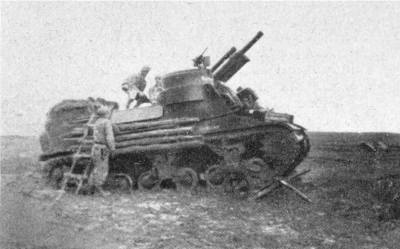
7 December
In order to get sufficient elevation, 105mm SP guns, part of an armored unit engaged in the assault of the German town of Kleinblittersdorf, are jacket up on logs.
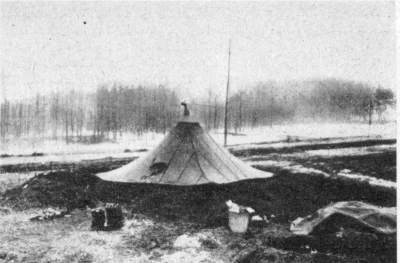
7 February, '45
This is a typical billet of the men of the Field Artillery and conditions and places in which they lived.
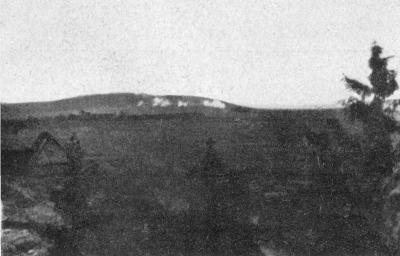
21 February
Smoke screen laid down around German town of Dahnen by men of the 6th Armored Division.
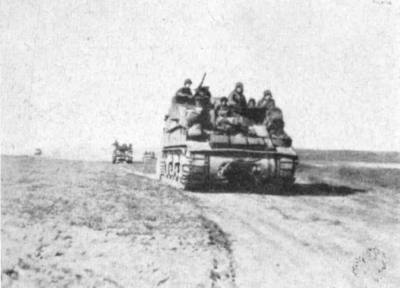
25 March
A 105mm SP M-7 of the 128th AFA Bn. Breaks out of camouflaged hiding along the Rhine and heads for Frankfurt as supporting artillery.
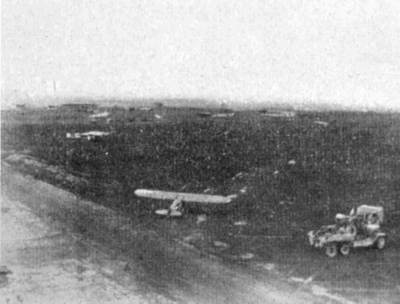
7 April, '45
A Piper Club taking off on a German air field just captured by CC B near Muehlhausen.
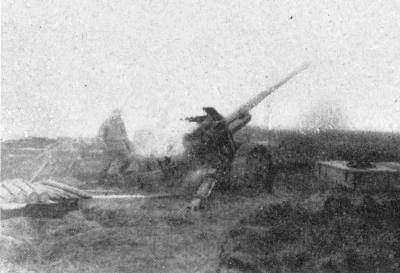
21 December
Captured 88mm's being turned on the Germans near Gurnville, France, following capture of several of the guns.
NOTE: Remove question mark from address below when sending email
This page is maintained by Bruce Frederick, EMAIL .
Last updated: March 2, 2002









